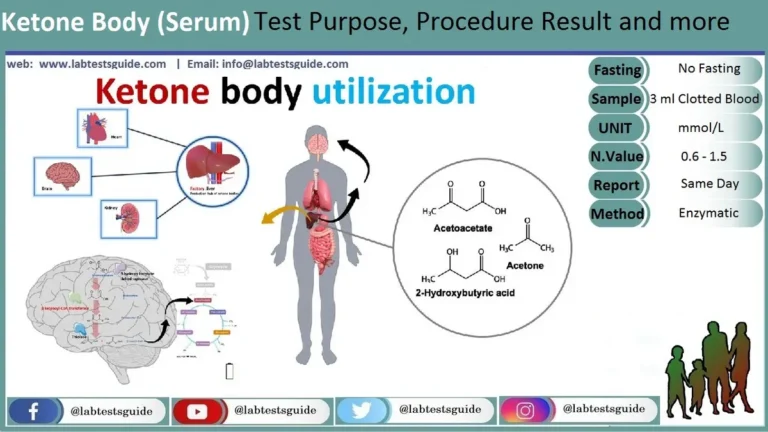The serotonin metabolite test is also known as the 24-hour urine 5-hydroxyindoleacetic acid (5-HIAA) test. This diagnostic tool is used to detect the presence of serotonin-producing tumors, such as carcinoid tumors. The test involves collecting all urine passed over a 24-hour period and analyzing it for the presence of 5-HIAA, which is a metabolite of serotonin. High levels of 5-HIAA in urine may indicate the presence of a carcinoid tumor or other conditions that cause increased serotonin production. However, false positives and negatives can occur, and dietary restrictions and medication adjustments may be necessary prior to the test. If you have concerns or questions about the serotonin metabolite test, it is important to discuss them with your healthcare provider.
| Also Known as | HIAA Serotonin Metabolite 5-HIAA 5-hydroxyindoleacetic Acid 24 hour Urine 5-hydroxyindoleacetic acid 24 hour 5-HIAA, |
| Test Purpose | diagnose and monitor carcinoid tumors or other conditions related to serotonin metabolism. |
| Test Preparations | Avoid banana, kiwi, walnut, avocado, brinjal, pineapple, plum, tomato & drugs like Fluorouracil, Melphalan, Paracetamol & Acetaminophen, Heparin, L-dopa, Reserpine, Salicylates, Chlorpromazine, Imipramine, Isoniazid, MAO inhibitors, Phenothiazines, Promethazine, alcoholic beverages, caffeine, tea/coffee, tobacco and strenuous exercise at least 72 hours before and during specimen collection. |
| Specimen | 50 mL (10 mL min.) aliquot of 24 Hours Urine. |
| Stability Room | 8 Hour |
| Stability Refrigerated | 1 Week |
| Stability Frozen | 1 Month |
| Method | HPLC |
| Download Report | Download 5-HAA Here |

Introduction of Serotonin Metabolite Test:
The 24-hour urine 5-hydroxyindoleacetic acid (5-HIAA) test is a diagnostic tool used to measure the levels of 5-HIAA in the urine. This test is typically used to diagnose and monitor carcinoid tumors, a type of neuroendocrine tumor that can produce serotonin and other hormones. The test involves collecting all urine produced over a 24-hour period and sending it to a laboratory for analysis. Elevated levels of 5-HIAA in the urine may indicate the presence of a carcinoid tumor or other conditions that affect serotonin metabolism.
Defination of 24 hour Serotonin Metabolite Test:
The 24-hour urine 5-HIAA test is a medical diagnostic tool that measures the levels of 5-hydroxyindoleacetic acid (5-HIAA) in urine to help diagnose and monitor carcinoid tumors or other conditions related to serotonin metabolism.
Alternative Names of Serotonin Metabolite Test:
- 5-HIAA urine test
- 24-hour urine serotonin test
- Urinary 5-hydroxyindoleacetic acid test
- 5-HT urine test
- Carcinoid urine test
- Serotonin metabolite urine test
- 5-Hydroxytryptamine urine test
- 5-Hydroxyindoleacetic acid excretion test
- 5-HIAA 24-hour urine test
- 5-Hydroxytryptophan urine test
- Neuroendocrine tumor urine test
- Tryptophan metabolite urine test
- Carcinoid syndrome urine test
- Serotonin urine test.
Purpose of Test:
Here are the common purposes of the 24-hour urine 5-HIAA test:
- Diagnose carcinoid tumors: The test is used to detect and diagnose carcinoid tumors that produce excess serotonin and other hormones.
- Monitor treatment: The test can be used to monitor the effectiveness of treatment for carcinoid tumors and other conditions that affect serotonin metabolism.
- Determine prognosis: The test results can help determine the prognosis for people with carcinoid tumors.
- Rule out other conditions: Elevated levels of 5-HIAA in the urine may also indicate other conditions related to serotonin metabolism, such as serotonin syndrome, pheochromocytoma, and mastocytosis. The test can help rule out these conditions.
- Evaluate serotonin-related symptoms: The test can help evaluate symptoms related to excess serotonin, such as diarrhea, flushing, and wheezing.
When the test is Ordered:
Here are some common reasons why a doctor might order a 24-hour urine 5-HIAA test:
- Suspected carcinoid tumor: The test is commonly ordered when a doctor suspects that a patient may have a carcinoid tumor that produces excess serotonin and other hormones.
- Symptoms of carcinoid syndrome: The test may be ordered when a patient presents with symptoms of carcinoid syndrome, such as flushing, diarrhea, or wheezing.
- Follow-up after treatment: The test may be ordered to monitor the effectiveness of treatment for a carcinoid tumor or other condition related to serotonin metabolism.
- Evaluation of serotonin-related symptoms: The test may be ordered to evaluate symptoms related to excess serotonin, such as flushing, diarrhea, or wheezing.
- Evaluation of other conditions: The test may be ordered to rule out other conditions related to serotonin metabolism, such as serotonin syndrome, pheochromocytoma, or mastocytosis.
Test Preparations:
Here are some common preparations that a patient may need to follow before taking a 24-hour urine 5-HIAA test:
- Dietary restrictions: The patient may need to follow a special diet for several days before the test, avoiding foods that are high in serotonin, such as bananas, tomatoes, and walnuts.
- Medication restrictions: The patient may need to stop taking certain medications that can affect serotonin levels, such as antidepressants and antipsychotics.
- Abstinence from alcohol: The patient may need to avoid drinking alcohol for several days before the test.
- Urine collection container: The patient will need to obtain a sterile urine collection container from the laboratory or pharmacy where the test was ordered.
- Record keeping: The patient will need to record the start and end times of the urine collection period, and may need to record any relevant symptoms or medications taken during the test period.
Avoid banana, kiwi, walnut, avocado, brinjal, pineapple, plum, tomato & drugs like Fluorouracil, Melphalan, Paracetamol & Acetaminophen, Heparin, L-dopa, Reserpine, Salicylates, Chlorpromazine, Imipramine, Isoniazid, MAO inhibitors, Phenothiazines, Promethazine, alcoholic beverages, caffeine, tea/coffee, tobacco and strenuous exercise at least 72 hours before and during specimen collection.
How to collect 24 Hours urine sample:
Here are the general steps for collecting a 24-hour urine sample for the 5-HIAA test:
- Discard the first morning urine void: When you wake up, empty your bladder and discard the urine. This helps ensure that the sample collection period starts with a clean bladder.
- Begin the 24-hour collection period: Note the time and start collecting all urine passed for the next 24 hours. All urine should be collected, including the final void at the end of the 24-hour period.
- Store the urine: Urine should be stored in a clean, dry container with a lid. The container should be kept in a cool place, such as a refrigerator, during the collection period.
- Keep track of the urine volume and time: Record the time and volume of each urine void on a collection container label or in a log sheet provided by the laboratory. Make sure to include any missed or discarded voids.
- Finish the collection period: At the end of the 24-hour period, empty your bladder and add the final urine to the collection container.
- Return the sample to the laboratory: Bring the urine sample to the laboratory as soon as possible after completing the collection. It is important to keep the sample refrigerated during transport.
It is important to follow the specific instructions provided by the laboratory or healthcare provider for collecting a 24-hour urine sample, as the procedure may vary depending on the test being performed.
Serotonin Metabolite Test Normal Values:
24-hour urine 5-HIAA test, along with some short references and resources:
| Normal Values for 24-hour Urine 5-HIAA | Reference/Resource |
|---|---|
| Less than 10 mg in adults | MedlinePlus Medical Encyclopedia |
| Less than 5-7.5 mg in 24 hours for adults | Mayo Clinic Laboratories |
| Normal values may vary depending on age, sex, and other factors | ARUP Laboratories |
It’s important to note that these normal values may vary depending on the laboratory and testing method used, so it’s always best to consult with a healthcare provider for interpretation of test results.
Results Interpretation and follow up:
Here are some general guidelines for interpreting 24-hour urine 5-HIAA test results and potential follow-up:
- Normal result: If the 24-hour urine 5-HIAA level is within the normal range (typically less than 10 mg in adults), this may suggest that there is no significant serotonin-producing tumor or other condition affecting serotonin metabolism.
- Abnormal result: If the 24-hour urine 5-HIAA level is elevated, this may suggest the presence of a serotonin-producing tumor, such as a carcinoid tumor. However, other conditions that affect serotonin metabolism, such as certain medications or dietary factors, can also cause elevated levels.
- Further testing: If an abnormal 24-hour urine 5-HIAA level is detected, further testing may be necessary to confirm the diagnosis and determine the extent of the condition. This may include imaging tests, blood tests, and other specialized urine tests.
- Treatment: Treatment options for a serotonin-producing tumor or other conditions related to serotonin metabolism will depend on the underlying cause and may include surgery, medications, or other interventions.
It’s important to consult with a healthcare provider for interpretation of 24-hour urine 5-HIAA test results and to determine any necessary follow-up or treatment.
Results meaning:
Here are some possible reasons and meanings for a high result on the 24-hour urine 5-HIAA test:
- Serotonin-producing tumor: A high result on the 24-hour urine 5-HIAA test may be indicative of the presence of a tumor that produces serotonin, such as a carcinoid tumor.
- Other medical conditions: Certain medical conditions, such as inflammatory bowel disease or celiac disease, can affect serotonin metabolism and lead to elevated 5-HIAA levels.
- Medications and supplements: Certain medications and supplements, including some antidepressants and dietary supplements like tryptophan, can also affect serotonin metabolism and lead to elevated 5-HIAA levels.
- Diet: Consumption of foods high in tryptophan, such as bananas, avocados, and tomatoes, can cause elevated 5-HIAA levels.
It’s important to note that a high 24-hour urine 5-HIAA test result does not necessarily mean that there is a tumor or other serious condition present. Other factors, such as medication use or diet, may also contribute to an elevated result. Further testing and evaluation by a healthcare provider is necessary to determine the underlying cause and appropriate treatment plan.
Risks and Limitations:
Here are some potential risks and limitations associated with the 24-hour urine 5-HIAA test:
- Collection errors: Improper collection of the 24-hour urine sample, such as missing a void or discarding urine, can lead to inaccurate results.
- Dietary factors: Diet can affect 5-HIAA levels, so it is important to follow any dietary restrictions provided by the healthcare provider or laboratory prior to the test.
- Medications and supplements: Certain medications and supplements can affect 5-HIAA levels, so it is important to inform the healthcare provider of all medications and supplements being taken prior to the test.
- False positives and negatives: The 24-hour urine 5-HIAA test is not always accurate in diagnosing the presence of a serotonin-producing tumor or other conditions affecting serotonin metabolism. False positives and negatives can occur.
- Invasive testing: If an abnormal result is detected on the 24-hour urine 5-HIAA test, further testing may be necessary, which can be invasive and carry additional risks.
It’s important to discuss any potential risks and limitations of the 24-hour urine 5-HIAA test with a healthcare provider and to follow any instructions provided for optimal accuracy and safety.
FAQs:
What is a 24-hour urine 5-HIAA test?
A 24-hour urine 5-HIAA test is a diagnostic test that measures the level of 5-hydroxyindoleacetic acid (5-HIAA) in a person’s urine over a 24-hour period.
What is 5-HIAA?
5-HIAA is a breakdown product of serotonin, a neurotransmitter that is involved in the regulation of mood, appetite, and other physiological functions.
What is the purpose of the 24-hour urine 5-HIAA test?
The 24-hour urine 5-HIAA test is used to diagnose the presence of a serotonin-producing tumor, such as a carcinoid tumor.
How is a 24-hour urine 5-HIAA test performed?
A 24-hour urine 5-HIAA test involves collecting all urine passed over a 24-hour period and providing it to a laboratory for analysis.
What are normal values for the 24-hour urine 5-HIAA test?
Normal values for the 24-hour urine 5-HIAA test are typically less than 10 mg in adults.
What does a high result on the 24-hour urine 5-HIAA test indicate?
A high result on the 24-hour urine 5-HIAA test may indicate the presence of a serotonin-producing tumor or other condition affecting serotonin metabolism.
What are some potential causes of a high result on the 24-hour urine 5-HIAA test?
Potential causes of a high result on the 24-hour urine 5-HIAA test include a serotonin-producing tumor, certain medical conditions, certain medications and supplements, and dietary factors.
Is the 24-hour urine 5-HIAA test accurate?
The 24-hour urine 5-HIAA test is generally considered a reliable diagnostic test, although false positives and negatives can occur.
Are there any risks associated with the 24-hour urine 5-HIAA test?
There are typically no significant risks associated with the 24-hour urine 5-HIAA test, although collection errors and false positives and negatives can occur.
Is any special preparation needed for the 24-hour urine 5-HIAA test?
Some dietary restrictions may be necessary prior to the 24-hour urine 5-HIAA test, and medications and supplements may need to be temporarily discontinued.
What are some potential complications of a serotonin-producing tumor?
Complications of a serotonin-producing tumor may include flushing, diarrhea, heart valve damage, and liver metastases.
How is a serotonin-producing tumor treated?
Treatment for a serotonin-producing tumor will depend on the location and extent of the tumor, but may include surgery, chemotherapy, and other interventions.
Can dietary changes help manage a serotonin-producing tumor?
Dietary changes may be helpful in managing symptoms associated with a serotonin-producing tumor, but will not necessarily treat the underlying condition.
What should I do if I have questions or concerns about the 24-hour urine 5-HIAA test?
If you have questions or concerns about the 24-hour urine 5-HIAA test, it is important to discuss them with your healthcare provider, who can provide guidance and support throughout the testing process.
Conclusion:
In conclusion, the 24-hour urine 5-HIAA test is a useful diagnostic tool for detecting the presence of a serotonin-producing tumor, such as a carcinoid tumor. This test involves collecting all urine passed over a 24-hour period and analyzing it for the presence of 5-HIAA. While this test is generally considered accurate, false positives and negatives can occur, and dietary restrictions and medication adjustments may be necessary prior to the test. If you have concerns or questions about the 24-hour urine 5-HIAA test, it is important to discuss them with your healthcare provider.
References:
- National Cancer Institute. (2022). Carcinoid Tumors Treatment (PDQ®)–Patient Version. Retrieved from https://www.cancer.gov/types/gi-carcinoid-tumors/patient/carcinoid-treatment-pdq
- Mayo Clinic Laboratories. (2022). 5-Hydroxyindoleacetic Acid (5-HIAA), 24 Hour, Urine. Retrieved from https://www.mayocliniclabs.com/test-catalog/Clinical+and+Interpretive/80338
- Lab Tests Online. (2021). 5-HIAA. Retrieved from https://labtestsonline.org/tests/5-hiaa
- National Institute of Health. (2021). 24-hour urine collection
Possible References Used






